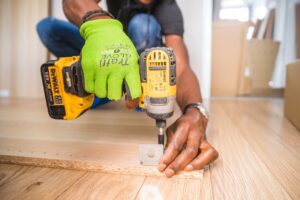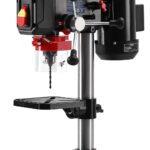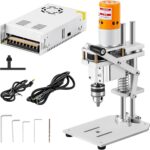Milescraft 1318 DrillMate Portable Drillling Guide – Precision Drilling Jig Attachment for Drilling Angled or Straight Holes, Adjustable Drill Guide Attachment, Portable Drill Press with 3/8” Chuck

$39.82
@ Amazon.com (Save 20%)
Product DescriptionPremium Home Improvement Tools: Perfect for straight or angled drilling; drilling on the edge of a board or on round stock
Sturdy Woodworking Tools: Attaches to all 3/8" & 1/2" cordless drills; it also includes a 3/8" capacity chuck with key
Multiple Angle Settings: Angle readout for setting drilling angles to 45°, 60°, 75°, and 90°
Versatile Carpentry Tools: Centering channels built into the bottom of the base, to accommodate drilling any round stock up to 3 inches in diameter
Premium Milescraft Tools: We offer products that help woodworkers and do-it-yourselfers to complete projects quickly, accurately, and easily.
Product Details| Brand: | Milescraft |
|---|
| Model #: | 1318 |
|---|
| Warranty: | Warranty |
|---|
| Size: | 1 PACK |
|---|
| Color: | Black Red Grey |
|---|
| Dimensions: | 16 X 5.5 X 18 inches (Length X Width X Height) |
|---|
| Price: | $39.82 (Save 20%) |
|---|
Milescraft 1318 DrillMate Portable Drillling Guide – Precision Drilling Jig Attachment for Drilling Angled or Straight Holes, Adjustable Drill Guide Attachment, Portable Drill Press with 3/8” Chuck
Milescraft 1312 Drill Block - Handheld Drilling Guide, Drilling Jig with Drill Guides for 6 of the Most Common Drill Bit Sizes, Precision Drilling Tool Accessory

$6.95
@ Amazon.com (Save 13%)
Product DescriptionSTURDY WOODWORKING TOOLS: Hardened steel guides - 1/8”, 3/16”, 1/4”, 5/16”, 3/8” and 1/2”
HOME IMPROVEMENT: Built-in vertical and horizontal centerlines for accurate alignment
CARPENTRY TOOLS: Non-slip feet hold the DrillBlock in place while preventing both slipping and marring on your work surface
USER FRIENDLY: Built in V-groove, allows for drilling on round stock or corners of stock
PREMIUM MILESCRAFT TOOLS: The perfect addition to your tool box to bring precision and quality to your work
Product Details| Brand: | Milescraft |
|---|
| Model #: | 1312 |
|---|
| Size: | Pack of 1 |
|---|
| Color: | Original Version |
|---|
| Dimensions: | 8 X 2.75 X 1.25 Inches (Length X Width X Height) |
|---|
| Price: | $6.95 (Save 13%) |
|---|
Milescraft 1312 Drill Block - Handheld Drilling Guide, Drilling Jig with Drill Guides for 6 of the Most Common Drill Bit Sizes, Precision Drilling Tool Accessory
Milescraft 1348 Drill Mate PRO – Heavy-Duty Portable Drill Press Drilling Guide, ½” Chuck, Precision Drilling Jig Attachment for Drilling Angled or Straight Holes, Adjustable Drill Guide Attachment
Product DescriptionAll metal construction and large ½” (13mm) keyed chuck for a heavy-duty professional drilling application
Infinite angle adjustments between 0° and 60° for drilling
Extruded aluminum guide head with brass bushings for more control and less play
Dual Spring Design Increases balance and control while drilling
Built in V-groove channel holds and centers round stock for drilling
Independent Depth Stop has own guide bar to prevent interference with springs
Product Details| Brand: | Milescraft |
|---|
| Model #: | 1348 |
|---|
| Price: | $124.99 (Save 17%) |
|---|
Milescraft 1348 Drill Mate PRO – Heavy-Duty Portable Drill Press Drilling Guide, ½” Chuck, Precision Drilling Jig Attachment for Drilling Angled or Straight Holes, Adjustable Drill Guide Attachment
Big Gator Tools STD1000DGNP V-Drill Guide

$24.95
@ Amazon.com (Save 19%)
Product Description17 drill sizes, from 1/8" to 3/8", in 1/64" increments
Use on flat surfaces, round parts, and corners
Special nickel alloyed steel heat treated for durability
Non-plated material with light oil coating to prevent rust
Alignment marks on guide to line up on center
Product Details| Brand: | Big Gator Tools |
|---|
| Model #: | STD1000DGNP |
|---|
| Warranty: | Lifetime warranty does not cover abuse |
|---|
| Size: | pocket size |
|---|
| Color: | Silver |
|---|
| Dimensions: | 5.5 X 0.8 X 0.85 inches (Length X Width X Height) |
|---|
| Price: | $24.95 (Save 19%) |
|---|
Big Gator Tools STD1000DGNP V-Drill Guide
Portable Drill Guide for Straight Holes, Heavy-Duty 0° to 60° Angle Drilling Guide, Drill Press Adapter for Hand Drill, Precision Adjustable Drill Jig Attachment with 1/2" Chuck
Product DescriptionMultifunctional Precision Engineering:This portable drill guide delivers versatile performance with its dual-lock stabilization system. Effortlessly adjust drilling angles from 0° to 60° using the precision-calibrated protractor scale: Simply disengage the quick-release locking pins, align your desired angle, and secure the position with ergonomic locking handles for accuracy and stability drilling. Integrated depth stop collar ensures uniform hole depths across repetitive drilling tasks Permanently etched crosshair alignment grid on the baseplate guarantees millimeter-accurate workpiece placement
Premium Aluminum Alloy Construction: Engineered from precision-machined 6061 aluminum alloy, this angle drill guide undergoes CNC machining and hard-anodization for unmatched durability. Its hardened surface resists scratches, corrosion, and rust even in demanding environments. The heavy duty base ensures wobble-free vertical drilling operations guarantees a rock-solid foundation for precision hole alignment.
Smart Engineering Features:Dual removable centering pins easily create centered holes in materials up to 4.9" wide. Integrated V-groove supports securely grip dowels, pipes, and tubing for stable, slip-free drilling. Dual tension springs instantly reset the drill to max height, simplifying bit changes and repetitive tasks.Four countersunk mounting holes secure the guide to workbenches or panels for hands-free operation
Wide Compatibility: This precision drill guide is suitable for 3/8" and 1/2" power drills, with a 1/2'' chuck that grips large bits easily. Smooth ball bearings in chuck carrier for efficient power transfer. Centering channels accommodate drilling any round stock up to 3 inches in diameter. You can remove the spring to increase Drill perpendicular holes up to 6.7 inches depth
Universal Versatility: Precision-engineered for both straight and angled drilling, this compact guide delivers professional-grade accuracy on drilling operations wood, metal, and composite materials. Compatible with all handheld drills, it streamlines woodworking projects, metal fabrication, and DIY home repairs—perfect for workshop professionals and weekend hobbyists alike
Product Details| Brand: | Gohelper |
|---|
| Model #: | LLT1039US |
|---|
| Color: | Red |
|---|
| Price: | $109.99 |
|---|
Portable Drill Guide for Straight Holes, Heavy-Duty 0° to 60° Angle Drilling Guide, Drill Press Adapter for Hand Drill, Precision Adjustable Drill Jig Attachment with 1/2" Chuck
Kings County Tool Portable Drill Guide Jig | Convert Hand Drilling to Drill Press | Bore Up To 45-Degree Angles | 3/8-Inch Shaft and Chuck | 5-Degree Increments | Depth Stop Included
Product DescriptionPORTABLE DRILL GUIDE - Use this angle drill guide for straight holes in wood every time by using this angle drill attachment to convert your hand-held drill into a portable drill press, perfect for woodworking hobbyists and professionals alike.
STANDARD SIZE - Our drilling jig attachment includes a standard 3/8” shaft and chuck for easy conversion, with wobble-free operation to achieve professional results. Note: For use with drill bits 1/2” (14mm) and smaller. Do not use with impact drills.
PRECISE ANGLE CONTROL - This drill block for straight holes allows you to bore at a precise angle from 90-degrees to 45-degrees in easily controlled 5-degree increments, for the same control you get from a drill press using your hand drill.
ESSENTIAL DRILL ACCESSORIES - The angle drill guide jig is a must for any tool chest, perfect for using at home or on the go thanks to the lightweight and portable design, while the included depth stop gives you precise control.
PRODUCT DETAILS - Materials: Steel and Plastic. Dimensions: (L) 18” x (W) 7” x (H) 3”; Weight: 0.28lbs. Mini Drill Press Straight Hole Drilling Guide Attachment for Handheld Drill. Use with Bits 1/2” or Smaller; Not Intended for Use with Impact Drills.
Product Details| Brand: | Kings County Tools |
|---|
| Model #: | GW91G01-05 |
|---|
| Color: | Black Gray |
|---|
| Dimensions: | 18 X 7 X 3 Inches (Length X Width X Height) |
|---|
| Price: | $44.63 |
|---|
Kings County Tool Portable Drill Guide Jig | Convert Hand Drilling to Drill Press | Bore Up To 45-Degree Angles | 3/8-Inch Shaft and Chuck | 5-Degree Increments | Depth Stop Included
Rockler Full-Size Drill Press Accessory - 0 to 60 Angle Drill Guide w/Protractor & Chuck Key
Product DescriptionDrilling Guide: Get the precision of a portable drill press with the portability of a hand drill, ideal for small shops that lack the space for a full-size drill press. Accepts the optional Self-Centering Drill Vise (sold separately) or buy the two together as a bundle.
Adjustable Angle: Our hand held drill guide can be used at any angle from 0° to 60° using the easy-to-read protractor scale. The depth stop lets you drill to the same depth again and again, nice for repetitive tasks like shelf pins.
Smooth, Precise Drill Stand for Hand Drill: Smooth, precise, and free of play, it gives you the accuracy and control of a drill press with the portability of a hand drill. Just attach your drill to the 1/4'' hex shank and drill away.
Comfortable Casings: Robust handles of our portable hand drill presses with comfortable rubber casings provide a substantial feel, while the hefty 1/2'' chuck grips large bits with ease. Glassy smooth ball bearings in chuck housing for efficient transfer of power.
Self-Centering Pins: Our depth stop lets you drill to the same depth again and again without stopping to readjust multiple times. Mounting holes on the base accept shop-made jigs, while the V-notches let you center holes in dowels and other round stock.
Product Details| Brand: | ROCKLER |
|---|
| Model #: | #52885 |
|---|
| Color: | Blue |
|---|
| Price: | $209.99 |
|---|
Rockler Full-Size Drill Press Accessory - 0 to 60 Angle Drill Guide w/Protractor & Chuck Key
JIG IT Drill Guide for Hand Drill & Presses - Durable & Versatile 90 Degree Drill Attachment Compatible w/Forstner Bits, Drill Stops, & More - Ideal Guide for Woodworking Projects
Product DescriptionCompatible with Drill Press & Hand Drills: The drill guides are compatible with both drill presses and hand drills, ensuring straight, aligned holes with every use; they keep the long shank drill bit steady, preventing wobbling or movement on your workbench or project
Accurate Flat-Bottomed Drilling: This drill jig for straight holes allows you to create precise flat-bottomed holes effortlessly; it works seamlessly with long shank Forstner Bits, drill stops, and a 3/8" Stop Collar, providing controlled depth and smooth operation
Sturdy & Reliable: Measuring 2-1/2" H x 3-1/2"D, this drill bit guide is made from durable plastic, providing reliable support for your drilling; it is built to last and handle everyday wear and tear in your workshop or DIY projects
Versatile & Precise Drilling: The drill guide jig is perfect for use on maple workbenches or for magnet installations on door closures, and cabinet hinges; it creates clean, accurate holes without damaging finished surfaces, providing a neat finish every time
What's included: Woodworking Jigs – (1) JIG IT Drill Guide, designed to help you drill with ease and precision, making your projects more efficient and accurate
Product Details| Brand: | ROCKLER |
|---|
| Model #: | 400000919812 |
|---|
| Price: | $19.99 |
|---|
JIG IT Drill Guide for Hand Drill & Presses - Durable & Versatile 90 Degree Drill Attachment Compatible w/Forstner Bits, Drill Stops, & More - Ideal Guide for Woodworking Projects
STD1000DGNP Drill Guide for Straight Holes, 17 Drill Sizes, From 1/8" to 3/8", in 1/64" Increments, Heat-Treated Steel, Drill Jig Block, Drill Bit Guide, Lifetime Free Replacement
Product DescriptionPrecision Drilling with Portability: The drill guide for straight holes offers the precision of a drill press in a portable, pocket-sized tool. Its innovative design ensures that even at a fraction of the cost, you get unmatched accuracy for every project, be it woodworking or metalworking. The drill guide's precision ground base guarantees stability and straight, perpendicular drilling on flat surfaces.
Unique V-Groove Design: With its unique 90-degree "V-groove" design, this drill guide for hand drill allows for perfect alignment on round materials and corners, making it versatile enough for flat surfaces, pipes, rods, and irregular objects. In addition, the guide is deal for various materials, including wood, metal, and plastic. It's an all-in-one solution for challenging drilling tasks, offering the flexibility to work on a variety of surfaces without compromising precision. Its versatility makes it perfect for both professional workshops and home DIY enthusiasts.
Durable, Heat-Treated Steel for Longevity: Made from 100% heat-treated steel, the drill guide is built to last. Its natural steel finish ensures durability and resistance to wear, while the embedded numbered drill holes offer precision for up to 17 sizes(1/8 inch to 3/8 inch), making it ideal for a wide range of applications. The drill guide maintains its precision even with frequent use. Its sturdy construction ensures that it continues to deliver stable alignment and drilling accuracy over time, offering consistent performance.
User-Friendly and Easy to Store: Designed with ease of use in mind, the drill guide works seamlessly with clamps or simple hand pressure. Whether you're drilling on flat surfaces, round parts, or corners, it can simplifies the process, delivering straight holes every time. Its streamlined setup process eliminates the need for extra tools or complicated adjustments, speeding up workflows and enhancing efficiency. You will love the drill guide for its unmatched portability. Despite being lightweight and compact, it delivers professional-level precision in various work environments. It’s the perfect tool for those who need to move frequently or work on-site.
Lifetime Warranty for Peace of Mind: Backed by a lifetime warranty, this drill guide offers superior value, ensuring you have reliable, accurate drilling for years to come. Its sturdy construction and thoughtful design mean that you'll never have to sacrifice precision, no matter the material or task at hand.
Product Details| Brand: | TJCYGO |
|---|
| Model #: | STD1000DGNP |
|---|
| Price: | $23.99 |
|---|
STD1000DGNP Drill Guide for Straight Holes, 17 Drill Sizes, From 1/8" to 3/8", in 1/64" Increments, Heat-Treated Steel, Drill Jig Block, Drill Bit Guide, Lifetime Free Replacement
30 45 90 Degree Angle Drill Guide Jig for Hand Drill, Angle Drill Guide for Straight Holes and Angle Drilling, used for Stairs Handrails, Cable Railings, Decks, and Wood Posts Level design,with 4 Bits

$19.99
@ Amazon.com (Save 18%)
Product Description【Angle Drill Guide for Straight Holes】The angle drill block for straight holes is a 90 degree drill guide, which is very accurate for the drill block for straight holes
【Angle Drill Jig for Angled Holes】This angle drill guide for angle drilling is suitable for both 45 degree drill jig and 30 degree angle drill guide, allowing for easy and precise drilling at 30° and 45° angles.
【Euipped with 4 Drill Bits】This drill guide for hand drill includes four sizes of twist drills and four guide hole sizes: 3/8 inch (9.52 mm), 5/16 inch (7.93 mm), 1/4 inch (6.35 mm), and 3/16 inch (4.76 mm)
【Multifunctionality】Corner Drill Guide is suitable for construction projects, home improvement, woodworking, etc., meeting the needs of various DIY projects, used for Stairs Handrails, Cable Railings, Decks, and Wood Posts Level design
【You Will Get】VASTHOME 30-45-90 Degree Angle Drill Guide Jig *1, Instruction Manual *1. The operation is simple, allowing you to get started quickly, saving time and effort. We also provide 24/7 customer service, so if you have any questions about angle drill jig, feel free to ask. Wishing you a pleasant shopping experience!
Product Details| Brand: | VASTHOME |
|---|
| Model #: | CK-TOOL-7 |
|---|
| Color: | Red |
|---|
| Price: | $19.99 (Save 18%) |
|---|
30 45 90 Degree Angle Drill Guide Jig for Hand Drill, Angle Drill Guide for Straight Holes and Angle Drilling, used for Stairs Handrails, Cable Railings, Decks, and Wood Posts Level design,with 4 Bits
















